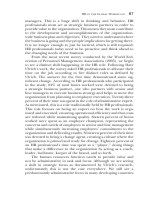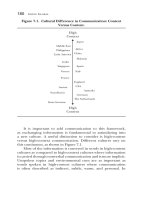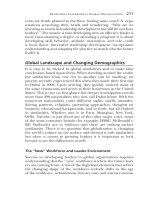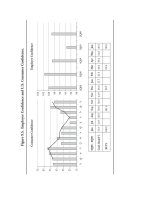Practical Applications and Recommendations for HR and OD Professionals in the Global Workplace_8 docx
Bạn đang xem bản rút gọn của tài liệu. Xem và tải ngay bản đầy đủ của tài liệu tại đây (516.45 KB, 31 trang )
180 Going Global
Figure 7.1. Cultural Difference in Communication: Context
Versus Content.
High
Context
High
Content
Japan
Africa
Middle East
Philippines
China
Latin America
India
Singapore
Greece
Spain
Italy
Malaysia
France
Swiss Germans
England
Austria
USA
The Netherlands
Germany
Australia
Scandinavia
It is important to add communication to this framework,
as exchanging information is fundamental to assimilating into
a new culture. A useful distinction to consider is high-content
versus high-context communication. Different cultures vary on
this continuum, as shown in Figure 7.1.
Most of the information is conveyed in words in high-content
cultures as compared to high-context cultures where information
is carried through nonverbal communication and is more implicit.
Unspoken topics and environmental cues are as important as
words spoken in high-context cultures where communication
is often described as indirect, subtle, warm, and personal. In
On-Boarding in a Global Workplace 181
contrast, high-content cultures are experienced as more direct,
impersonal, objective, and logical (Hall, 1976).
A comprehensive on-boarding approach focuses on bringing
the new hire up to speed on the internal culture of the orga-
nization and the local culture. Table 7.3 shows a list of specific
elements that contribute to the culture of an organization.
Table 7.3. Elements That Contribute to Organizational Culture.
Awards and
Ceremonies
How are employees recognized for performance? Are
there service awards or retirement events?
Social Events Are there routine informal events, such as
informal gatherings at local pub, or sporting
events?
Customer
Focus
To what extent does the organization value customer
service (versus production or sales)?
Decision
Making
Does the organization tend toward consensual decision
making? Are decisions usually made at the senior level
and distributed throughout the organization?
Dress Code Is the dress code formal or more casual?
Feedback Does feedback occur frequently and informally, or
more formally during scheduled sessions?
Information
Dissemina-
tion
How much information about the business is shared
throughout the organization? How is information
disseminated throughout the organization:
electronically, in meetings, one on one?
Leadership
Style
What is the style of senior leaders: are they autocratic,
participative, heroic, or accessible?
Physical
Environment
What does the typical working environment look like?
What is the work space of senior leaders?
Speed What is the sense of urgency in the company, to
respond to e-mails, telephone messages, work tasks?
Training What is the type and frequency of training provided to
employees?
Work Hours When are employees typically in the office? Are
employees expected to work weekends, holidays?
182 Going Global
The new hire’s line manager and colleagues play an important
role in articulating the internal culture of the organization. This
can be effectively accomplished by sharing stories that convey what
it is really like to work at your company. Written materials such as
policy manuals, internal newsletters, memos from senior leaders,
press releases, and so on should be gathered and shared with the
new hire as these can also help describe the unique personality
of the company and its local operations. Line managers and
colleagues and people from the new hire’s country of origin
are also instrumental in describing the local culture. Additional
sources of information such as history books, local art, traditional
foods, holiday celebrations, and the like can be very informative
about the norms and values of the local culture. Be explicit to
include local cultural aspects as well as internal company norms
when reviewing the elements shown in Table 7.3.
Stages of On-Boarding
Because socialization is the foundation of effectively on-boarding
new employees, or individuals new to role, we will illustrate
on-boarding practices according to the stages of socialization:
Anticipatory, Accommodation, and Role Management (Feldman,
1976). Anticipatory socialization occurs before an employee enters
the organization. This stage involves practices related to getting
into the organization. Accommodation socialization occurs as the
individual enters the organization and begins to understand what
the organization is really like and attempts to become a partic-
ipating member. In the role management stage of socialization,
the individual masters work tasks, settles into the job role, and
becomes a contributing member of the organization.
Stage 1: Anticipatory or Pre-Entry
Research has shown that the attitudes that newcomers develop
toward their new employer form very early and are relatively stable
over time (Bauer & Green, 1994). This highlights the importance
of paying attention to every detail associated with the candidate
selection process as the first stage of on-boarding. New employees
begin to develop an impression of the organization based on the
On-Boarding in a Global Workplace 183
professionalism of interactions with recruiters and organizational
members. Individuals involved in recruiting and interviewing pro-
cesses need to provide candidates with a realistic view of the role,
the challenges he or she will likely face, and, most important, a
glimpse into the culture of the organization. They need to make
candidates feel comfortable and welcome while gaining informa-
tion necessary to make an accurate assessment of the candidates’
skills and degree of ‘‘fit’’ within the organization.
Structured interviews are a valuable tool for assessing a candi-
date’s organizational fit; the results from these interviews can be
an indicator of the individual’s success or failure in role (Lomax,
2001). Structured interviews designed to assess organizational fit
should focus on character traits deemed essential by the company.
For individuals moving to roles outside their home company, traits
such as openness to experience, flexibility, persistence, and empa-
thy have been identified as key predictors of the individual’s
performance in role (McCall & Hollenbeck, 2002).
GlaxoSmithKline has institutionalized a ‘‘Candidate Care’’
model which is a process and prescribed set of behaviors that
applies a customer service model to candidates’ recruitment expe-
riences. Treat prospective employees in the same manner as your
valued customers, not as traditional job applicants. Ensure that
all applicants, those who successfully gain employment and those
who do not, have a positive story to share with others. Lou Manzi,
vice president of global recruitment, views GSK’s candidate care
process as a competitive advantage, one that enhances GSK’s rep-
utation as a preferred employer while increasing the firm’s brand
equity.
Practical steps for global hiring managers include the
following:
• Provide each applicant with a positive and realistic understand-
ing of the company
• Excite them about your brand by clearly and concisely describ-
ing what your firm stands for
• Involve people from diverse perspectives (that is, nationalities,
functions, tenure) in the interview process
• Don’t overpromise and underdeliver
184 Going Global
Stage 2: Accommodation or Organizational Entry
Effective on-boarding practices implemented during the new-
comer’s entry into the organization tap into the individual’s
innate motivation to understand and make sense of his or her new
environment. During this phase, three areas require focus: trans-
actional basics, performance expectations, and initial orientation.
Transactional Basics
The transactional basics truly represent a double-edged sword:
when executed well they are not sufficient to create an effective
on-boarding experience, but any lapses here will destroy even the
most comprehensive on-boarding effort.
Post-Offer Acceptance Communication. Communicate frequently with
the new employee after she has accepted the offer to welcome
her into the organization. Carefully craft any formal announce-
ment that will be issued internally or externally to introduce
the successful candidate. Include not just the candidate’s title
and background but introduce the audiences to his mandate:
what is he going to bring to the organization? Be sensitive to
cultural norms when announcing new employees or employees
transitioning to a new role. For example, announcements in
Western countries may be more detailed and highlight individu-
als’ accomplishments whereas Asian cultures may downplay past
successes.
The Move. A sound corporate relocation policy is essential to
ensuring a successful relocation. Though this sounds very basic,
it is surprising how many multinational corporations have vague
policies regarding relocation, whether for a new organizational
member or location moves for existing members. The policy
needs to be reviewed frequently to ensure relevance and it should
adequately address adaptations and exceptions. Service providers,
such as move management companies, cultural awareness
trainers, language training, and immigration and tax providers,
play an important role in most relocations. Ensure that they
provide early and frequent predeparture communication with
On-Boarding in a Global Workplace 185
the employee to ensure realistic planning for service delivery. It
is the responsibility of the organization, most likely the human
resource member of the on-boarding team, to serve as the point
of contact for the employee.
A critical component to successful relocation involves the
employee’s family unit. A now commonly known statistic cites lack
of adaptability by the employee’s spouse or partner as the number-
one reason for assignment failures (see, for example, Frazee,
1998, Lomax, 2001; McCall & Hollenbeck, 2002). A 1999 Global
Relocation Trends survey reported data from 177 companies with
more than 50,000 U.S. expatriates on active assignments overseas;
more than 50% of the companies surveyed listed the following
family challenges as critical:
• family adjustment
• children’s education
• spouse or partner resistance
• spouse or partner career
Despite the preponderance of evidence and common sense
suggesting that early identification and adequately addressingfam-
ily challenges will establish a comfort zone allowing the employee
to concentrate on work, very few companies involve the employee’s
family in screening and/or selection decisions (Global Reloca-
tion Trends, 1999). (See Chapter 12 on Expatriation for more
information.)
Day 1 Experience. Planning for the employee’s first day in the
new environment is again very basic, but often overlooked. Take
advantage of the employee’s enthusiasm on Day 1; make the
newcomer feel comfortable and trusting that this assignment
is the right one for her. Ensure that there is a plan for greeting
the employee upon arrival and assistance with building access and
security as necessary. Also ensure that someone is accountable
for establishing work station basics including computer, e-mail
and intranet access, telephone. The ‘‘Day 1’’ checklist shown in
Figure 7.2 provides further examples of important items to ensure
the employee experiences a positive Day 1.
186 Going Global
Figure 7.2. Day 1 Checklist.
Welcome
Inform existing staff of new arrival and their role
Send welcome announcement
Greet new person and introduce staff
Facilities
Car parking
Staff room and kitchen facilities
Telephone—external and internal dialing instructions
Fax machine
Fire extinguishers
First aid boxes
Health and safety notices, including accident book
Utilities, such as lighting, heating, water
Access to buildings, security
Incoming and outgoing mail points
Notice boards
Computer system, Internet access, e-mail
Photocopier
Stationery stocks and systems of reordering
Toilets, cloakroom, and so on
The organization
What we do
History of the organization
Organizational structure
Market trends
Future plans
Terminology used in organization
On-Boarding in a Global Workplace 187
Figure 7.2. (continued)
Systems
Office systems—computers, telephones, filing
Courtesies—protocol, etiquette
Hours of work, timesheets
Absence from work—annual leave, bank holidays, sickness
Communications
Meetings
Finance—expense claims, financial responsibilities
Policies and Personal Development
Training
Company policies (such as Development; Health and Wellness; Corporate
Social Responsibility, and so on)
Performance management process
Salary review guidelines
Performance Expectations
Ensure the employee’s line manager is available during the
employee’s initial arrival at the organization to clarify account-
abilities and establish priorities. This needs to be an ongo-
ing dialogue, but the line manager sets the stage on Day 1
for a successful relationship with the new employee. Sched-
ule a two-hour block of time for the line manager and new
employee to meet on Day 1. As Gallop’s research has shown, the
employee’s line manager plays the most important role in influ-
encing employee engagement and performance (Buckingham &
Coffman, 1999).
The line manager’s role in effectively establishing perfor-
mance expectations for the new hire includes the following:
• Provide an overview of the function’s role in the business and its
relationship to other functions
• Review the role description and agree on priorities and
timetables
188 Going Global
• Agree on how performance will be judged, who will be involved
in evaluating performance, and how performance will be
rewarded
• Define development goals
• Set up periodic informal evaluations
Some organizations highlight the critical role of the line
manager in effectively on-boarding new hires by including metrics
such as the percentage of time dedicated to on-boarding efforts
and turnover rates as part of line managers’ performance ratings.
3.Orientation
According to a survey by the Society for Human Resource Manage-
ment, 83% of companies report the use of a formal orientation
program for new employees. Unfortunately, the usefulness of
such programs from the perspective of the new employee varies
significantly. Some programs focus solely on communicating fac-
tual information about pay and benefits, company rules and
policies, and completing paperwork. Most of these activities can
be accomplished more efficiently and effectively with supporting
technology, allowing the employee to access the information when
necessary.
Table 7.4 highlights some of the common problems associated
with orientation programs from the perspective of new employees
(Werner & DeSimone, 2006).
Best practice companies approach new employees’ orientation
in very different ways. They design orientation programs that
concentrate on emotional takeaways and many identify a peer
coach or ‘‘buddy’’ to help orient the newcomer. The peer coach
is preferably the same level as the new employee and has tenure
of at least six months with the organization. In addition, the peer
coach should:
• Prepare a list of what he or she would have wanted to know
about the organization when he or she first entered
• Be available for 15 minutes per day during newcomer’s first
week
• Provide feedback and encouragement to the newcomer
• Provide guidance on expanding networks within the company
On-Boarding in a Global Workplace 189
Table 7.4. Common Problems with Orientation Sessions.
Problem Recommendation
Too much
paperwork
Most documents such as Personal Information,
Bank Details, Tax Forms, Medical Information, and
so on can be completed prior to the orientation.
Many organizations offer access to the company
intranet and provide clear guidance on information
required along with a contact person for questions
prior to the employee’s Day 1.
Information
overload
Don’t try to cram 20 hours of information into a
three-hour session. Newcomers generally lack the
ability to prioritize the information provided; focus
on critical pieces of information only.
Information
irrelevance
Consider your audience. Typically a wide variety of
employee skills and roles are represented in the
audience. Don’t spend time on details that are
irrelevant to your general audience.
Too much
selling of the
organization
The new employees have already ‘‘bought.’’ Build
on this fact.
Too much
one-way
communication
Take advantage of opportunity to allow new
employees to ask questions and to begin to build
networks. Building relationships with people in the
room is more important than any information
provided.
Lack of
follow-up
Ensure that information (including contact details
of attendees) from orientation is available
post-orientation. Provide a simple check-in with new
employees 30 days post-orientation.
• Serve as a sounding board and informal source of information
for questions related to policies, processes, work rules, and cor-
porate or local style and norms, for example.
In terms of more formal orientation sessions, best practice
companies use the time to describe the company’s history and
values and help employees feel connected to the company’s
190 Going Global
business strategy and financial goals. As Diana Oreck, vice pres-
ident of Ritz-Carlton’s Global Learning and Leadership Center
said, ‘‘People don’t remember what you said or what you did
but they always remember what they felt.’’ Southwest Airlines is
an example of another company that focuses its orientation pro-
gram on creating a positive emotional experience. The emotions
and feelings elicited in effective orientation programs include
welcome, comfort, security, pride, excitement, confidence. In
addition to sharing key information about the company (such
as history, values, strategy, organizational structure, and so on),
consider inviting respected employees and leaders to share client
success stories. These examples can give newcomers a sense of
accomplishment knowing they are working for a company that is
respected in the marketplace. In addition, stories relayed from
current employees and managers can help new employees begin
to visualize how they can help contribute to organizational success.
It is customary for orientation programs to be implemented
locally. In more advanced global organizations, common content
provided from the corporate group is incorporated into local
orientation sessions. Examples of this common content might
include a welcome message from the CEO, visions for future,
and high-level description of market results and strategic drivers.
Stories from senior leaders from around the world may be high-
lighted through videotaped messages. Depending on the level
and role and number of new employees, some organizations may
follow a local orientation with a global assimilation event (often
held at the company headquarters location). This kind of event
is designed to catalyze relationships with senior leaders and with
other new employees on a global scale and offers a nice transition
from the Accommodation stage of on-boarding to the final Role
Management stage.
Stage 3: Role Management
Building and managing relationships is the focus of the role man-
agement stage of on-boarding. This stage takes time, although the
combination of the right individual and efficient organizational
practices can accelerate the process. The value of establishing solid
On-Boarding in a Global Workplace 191
relationships with the employee’s new manager, direct reports,
peers, and other organizational members is well documented.
Research has consistently shown that people rely on other people
to get the information they need to get their jobs done (Cross,
2007). Newcomers are instantly at a disadvantage as they are on
the periphery of the web of relationships within the organization.
Organizational practices can facilitate and support newcomers to
build effective relationships with their manager, team, and larger
group of stakeholders.
Line Manager
The relationship with his manager is one of the most significant
in an employee’s career (Buckingham & Coffman, 1999). An
employee’s immediate manager is responsible for performance
management and career development processes, as well as provid-
ing ongoing coaching and feedback. Managers need to be involved
in every stage of the on-boarding experience, but some organi-
zations focus specific attention on ensuring that line managers
are skilled in working with new employees to establish objectives,
review progress, and provide constructive feedback designed to
facilitate the employee’s transition into the organization. Fur-
ther, the line manager plays an instrumental role in helping the
employee build important work relationships by providing appro-
priate introductions and, most important, in carefully considering
the first assignment for the new employee. Initial work projects
should require assistance from colleagues, especially those in dif-
ferent functions and departments. Avoid assigning initial projects
that involve working with external partners or suppliers. When
line managers review progress with the newcomer they should ask
not only ‘‘What have you accomplished?’’ but also ‘‘Who have you
established relationships with?’’
In global organizations, especially at senior levels, it is likely
that the newcomer’s immediate manager is not located in close
physical proximity. Managing virtual relationships has been
touched upon in other chapters (see for example, Chapters 1 and
4), but it is important to highlight here as well. New employees
who have remote managers need to assume 100% of the
responsibility for establishing and maintaining the relationship.
192 Going Global
Find a way to spend time together face-to-face, especially in
the early days. It’s recommended that the new employee’s line
manager travel to the newcomer’s location in the first week to
facilitate introductions and establish objectives. Also agree on
regular times and means for checking-in with each other; ideally
this will be weekly or biweekly during the initial transition period
and over the phone (not via e-mail).
Direct Reports
A process that has been used successfully at GE for years is focused
on relationships between the new employee and his or her direct
reports. GE refers to this as the New Manager Assimilation Process
and similar processes are used at many global companies including
Citigroup and Honeywell. A New Manager Assimilation Process
centers around three areas:
1. Relationship Management: setting the foundation by clarifying
roles, relationships of team, work climate, trust, and openness
2. Boundary Management: identifying critical priorities of the busi-
ness, understanding challenges and opportunities, and stake-
holders
3. Leadership Action: strategy structure, support, follow-up actions
of manager and team
The NMAP can take anywhere from a half day to one-and-a-
half days, and successful programs have a subsequent follow-up
session to check in and evaluate how things are going. The follow-
up normally takes place four to six months after the NMAP. In its
most basic form, data is collected from the new manager’s team,
summarized, and returned to the new manager who, together
with a coach, reviews the questions and prepares for a face-to-face
feedback session with the new team. Questions may include, but
do not need to be limited to, these examples:
• What do we already know about [New Manager]?
• What don’t we know but would like to know about [New
Manager]?
On-Boarding in a Global Workplace 193
• What are our concerns about [New Manager]?
• What do we want most from [New Manager]?
• What does [New Manager] need to know about us?
• What are the major challenges we face as business, function, or
team?
During the feedback session, the new manager responds to
the input and the questions gathered from the team. He or she
engages in dialogue with the team and agrees on actions. A sum-
mary of the feedback session is reviewed three to six months later.
The success of any New Manager Assimilation Process is depen-
dent upon an experienced, trained, and skilled facilitator. Prework
for these processes varies but may include an assessment of team
learning style and communication style, and could also include a
leadership style assessment for the new manager.
At Citigroup the NMAP was focused on the following
outcomes:
1. Enable a smooth transition for the new manager and the
manager’s team
2. Create a dedicated space for open dialogue and to share
information
3. Build relationships for effective work flow by clarifying infor-
mation and addressing misconceptions
4. Clarify vision and objectives through dialogue focused on shar-
ing, enhancing, and refining direction
5. Identify significant actions for the next six months
Generally the NMAPs are used for senior-level appointments
but an abbreviated version can be useful for employees at all
levels. This approach has been tested and used effectively in
Western cultures; see the following NMAP Process Example for an
explanation of the process at a major international gas company.
As indicated previously, it is important to apply techniques that
‘‘fit’’ into local cultures. A modified version of the NMAP where
information is provided to the new manager in written form, for
example, may be more effective in high-context cultures.
194 Going Global
NMAP Process Example
On-Boarding: Framework for Individual Support (12–18 Months)
• Stage I: Initial integration meeting
Takes place within first 30 days
• Stage 2: integration meeting (NMAP with team)
Takes place within first 90 days)
• Stage 3 integration meeting (Check-in)
Takes place within first 6 months
• Stage 4 integration meeting (Final check-in)
Takes place between 12 and 18 months
This work is coordinated and facilitated by a member of the
corporate executive development team working closely with the
local human resources manager and the new manger’s boss.
The work would include developing a formal integration plan,
arranging a mentor, liaising with the line manager, providing
360-degree feedback to the individual, and facilitating the inte-
gration with the team meeting. This corporate resource helps
the new manager navigate the internal landscape, network with
key stakeholders, quickly learn the internal ‘‘rules of the road’’
and is especially significant for those new managers that are
globally dispersed away from the corporate center. It is essential
for someone knowledgeable about the corporate center and the
key players to facilitate the on-boarding process. This process
greatly speeds up the new manager’s time-to-effectiveness.
Stakeholders
As more organizations realize the importance of social networks,
many are investing in a process of gathering stakeholder input
and mapping an initial network for the new employee. This
investment has resulted in reduced turnover and greater employee
engagement in diverse industries including financial services,
energy, technology, and health care.
Ideally the stakeholder input is gathered prior to the new
employee’s first day and focuses on four basic areas:
1. What are the expectations associated with role new leader is
stepping into?
On-Boarding in a Global Workplace 195
2. What challenges might the new leader face?
3. Insights and advice concerning our culture?
4. Who are the key people in the organization that this leader
must establish good relationships with?
A skilled transition coach, internal (ideally the HR member of
the on-boarding team) or external to the organization, facilitates
the process by attending to the details outlined in the following
Stakeholder Input Process.
Stakeholder Input Process: Transition Coach
Responsibilities
• Communicating the objectives of the process throughout the
organization, and specifically with hiring managers
• Ensuring support for the process from the hiring
manager
• Meeting with hiring manager to document his or her expecta-
tions associated with role, insight or advice regarding culture,
and gathering names of key stakeholders to participate in
process
• Working with line manager to craft invitation to stakeholders
to participate in a brief interview as part of assimilation of
new hire
• Interviewing key stakeholders
• Summarizing data, ensuring confidentiality of input
• Reviewing summary report with hiring manager and with new
employee
• Providing ongoing coaching and follow-up support to hiring
manager and new employee
Putting It All Together
We’ve discussed a number of elements that contribute to an
effective on-boarding process. Table 7.5 shows a time line of key
on-boarding activities starting from the time the new employee is
identified.
196 Going Global
Table 7.5. Putting It All Together.
When What Who
2–4 weeks prior
to start date
Prepare on-boarding plan Line manager
2–4 weeks prior
to start date
Organize on-boarding team (for
example, HR professional, peer
coach)
Line manager
2–4 weeks prior
to start date
Plan for move with service
providers
HR professional,
new hire
2–4 weeks prior
to start date
Schedule cultural assessment
and coaching
HR professional
2–4 weeks prior
to start date
Prepare post-offer acceptance
communication (including
internal or external
announcements)
HR professional,
line manager
2 weeks prior to
start date
Prepare announcement Line manager
2 weeks prior to
start date
Plan Stakeholder Analysis;
schedule and conduct interviews
HR professional
Day 1 Complete Day 1 Checklist HR professional or
peer coach
Day 1 New hire and line manager meet Line manager
Weeks 1–2 Arrange 1–1 meetings with team
members
Line manager, new
hire
Weeks 1–2 Arrange 1–1 meetings with peers
and role model leaders
Line manager, new
hire
Weeks 1–2 Review feedback report from
Stakeholder Analysis with line
manager
HR professional
Weeks 1–2 Review feedback report from
Stakeholder Analysis with new
employee
HR professional,
Line manager
Weeks 2–3 Manager and new hire complete
performance objectives,
development plan
Line manager
(continued overleaf )
On-Boarding in a Global Workplace 197
Table 7.5. (continued)
When What Who
Weeks 2–9 New Hire visits operations,
customer outlets, etc.
Line manager
Weeks 2–9 New Hire meets external
vendors, suppliers, customers
Line manager
Weeks 2–4 Complete NMAP: data input HR professional
Ongoing Schedule weekly or biweekly
check-in meetings with line
manager
New hire
Weeks 4–8 Complete NMAP: Team dialogue HR professional,
new hire
Weeks 16–24 Follow-up NMAP HR professional,
new hire
The Future of On-boarding
As indicated previously in this chapter, there is very little
information available regarding on-boarding practices in global
organizations. As the number of global organizations continues
to increase, and consequently the number of employees working
outside of their country of origin continues to increase, there
is clearly an adequate sample to investigate basic questions.
For example, what best practices exist regarding on-boarding
employees into global organizations? We’ve highlighted some
in this chapter, but mostly from our own experience base.
Compiling a comprehensive set of best practices, and lessons
learned, from employees who have been effectively on-boarded
into global organizations would be useful. In addition, it would
be important to understand the costs (such as financial, resource
commitment) associated with on-boarding practices.
It would be valuable for researchers to investigate the following
areas related to on-boarding:
1. What is the failure rate for new hires or employees who transfer
to a new location within global company; do failure rates differ
if newcomers enter in headquarters locations versus remote
198 Going Global
locations? What impact does an effective on-boarding process
have on this?
2. Can overall performance of global organizations be compared:
those that invest in on-boarding and those that do not?
3. What are the more long-term outcomes of on-boarding, such
as career progression, promotion?
4. Do employees who go through effective on-boarding processes
build more effective virtual teams? Do their teams score higher
on engagement indices that those employees who have not
gone through on-boarding?
Organizations that implement on-boarding practices such as
New Manager Assimilation Processes and Stakeholder Analyses
have a wealth of information within these data sets. For example,
stakeholder perceptions of the organization’s culture could be
analyzed and applied more broadly to other HR processes, includ-
ing organizational reviews, recruiting, and communication.
References
Aberdeen Group. (2006). Onboarding benchmark report: Technology drivers
help improve the new hire experience. Boston: Aberdeen Group.
Allen, D. G. (2006). Do organizational socialization tactics influence
newcomer embeddedness and turnover? Journal of Management,
32(2), 237–256.
Bauer, T. N., & Green, S. G. (1994). Effect of newcomer involvement in
work-related activities: A longitudinal study of socialization. Journal
of Applied Psychology, 79, 211–223.
Bossert, R. (2004). Transition coaching activities accelerates leadership success.
Chief Learning Officer on CLOmedia.com.
Bradt, G. B., & Vonnegut, M. (2009). Onboarding: How to get your employees
up to speed in half the time.NewYork:Wiley.
Bradt, G., Check, J. A., & Pedraza, J. (2006). The new leader’s 100-day action
plan. Hoboken, NJ: Wiley.
Buckley, P. J., & Ghauri, P. N. (2004). Globalisation, economic geography
and the strategy of multinational enterprises. Journal of International
Business Studies, 35(2), 81–98.
Buckingham, M., & Coffman, C. (1999). First, break all the rules.NewYork:
Simon & Schuster.
Ciampa, D., & Watkins, M. (1999). Right from the start: Taking charge in a
new leadership role. Boston: Harvard Business School Press.
On-Boarding in a Global Workplace 199
Corporate Leadership Council. (2006). Attracting and retaining critical
talent segments (Volume I), Washington, DC: Corporate Executive
Board.
Cross, R., & Prusak, A. (2002). The people who make organizations
go—or stop. Harvard Business Review, 80, 1–22.
Dai, G., & DeMeuse, K. P. (2007). A review of on-boarding research.
Korn/Ferry International.
Feldman, D. C. (1976). A contingency theory of socialization. Adminis-
trative Science Quarterly, 21, 433–452.
Frazee, V. (1998). Keeping your expats healthy. Workforce, November,
19–23.
Gabarro, J. J. (1987). The dynamics of taking charge.Boston:Harvard
Business School Press.
Global Relocation Trends. (1999). Survey Report. Windham Inter-
national, National Foreign Trade Council and Institute for
International Human Resources, p. 24 .
Hall, E. T. (1976). Beyond culture. New York: Doubleday
Lomax, S. (2001). Best practices for managers and expatriates.NewYork:
Wiley.
McCall, M. W., & Hollenbeck, G. P. (2002). Developing global executives.
Boston: Harvard Business School Press.
Miller, V. D. (1996). An experimental study of newcomers’ information
seeking behaviours during organizational entry. Communication
Studies, 47, 1–24.
Pomeroy, A. (2006). Better executive onboarding processes needed. HR
Magazine, 51(8), 16.
Rhinesmith, S. H. (1996). A manager’s guide to globalization.NewYork:
McGraw-Hill.
Scullion, H., and Collings, D. (Eds.) (2006) Global staffing.London:
Routledge.
Smith, D. M. (1989). Organizational socialization of physical therapists.
Physical Therapy, 69(4), 282–286.
Tichey, N. (1983). Managing strategic change: Technical, political and cultural
dynamics. New York: Wiley.
Van Maanen, J., & Schein, E. H. (1979). Toward a theoryoforganizational
socialization. Organizational Dynamics, Summer, 19–36.
Watkins, M. (2003). The first 90 days. Boston: Harvard Business School
Press.
Werner, J. M., & DeSimone, R. L. (2006). Human resource development
(4th ed.). Mason, OH: South-Western Cengage Learning.
PART 3
Maximizing
Performance
in the Global
Workplace
CHAPTER 8
Developing Leadership
in Global Organizations
Tommy Weir
Gone are the days of preparing for a single-country career and
the days of being a one-country company, as employees and orga-
nizations now live in the troughs of globalization and are not
bound by geographic borders. Yet many companies still practice
a single approach to developing leaders, and many operate on
the assumption that ‘‘leading’’ is the same all over the world. It
is time to move beyond this ideal. This is a simplistic and risky
practice because it is does not contribute to maximizing the invest-
ment made in leadership development, nor does the single-source
approach result in the sought-after outcomes of employee engage-
ment, performance, and organizational success. This chapter will
aid organizations with understanding the implications of the con-
temporary practices of global leadership development and will
recommend what should be practiced when developing leaders
in global organizations, highlighting the importance of grafting
local identity with the global organization’s culture.
There is no escaping the fact that there is a global consistency
in ‘‘what’’ leadership is, as every company requires leaders to
help direct and fulfill its strategic vision. However, the confusion
comes in mistaking the ‘‘what’’ and ‘‘how’’ of leadership, as there
are vast differences in terms of styles of leadership, focus on task
versus consideration, charisma, and transformation in comparison
to tactical knowledge and strategy. To illustrate this point, think
203
204 Going Global
about your experiences of traveling abroad and drinking a Coca-
Cola (or if you have not traveled abroad perhaps, you have tasted
different international versions of Coke in the Coca-Cola museum
in Atlanta or at Epcot). Prior to such an experience, the immediate
assumption is that Coke is the same all over the world. But is it?
Consistently, the color of the liquid is dark caramel, it is best when
cold, it has similar ingredients, and the container is the same
trademark red color, but the taste varies greatly from one region
to another. The ‘‘what’’ of Coke is the same all over the world—a
soft drink to quench thirst, but ‘‘how’’ it tastes varies by region to
match the local needs. The same concept is true for leadership.
The four-component parts of leadership—the leader, the
follower(s), the interaction between the two, and the outcome or
goal—appear to be similar all over the world. As the parts appear
to be consistent, organizations attempt to import and export the
practice of developing leaders from one market to the next, yet
this actually falls short of the desired outcome. The problem in
this approach is that each of the four leadership components
varies from country to country.
The flavor of leading and leadership development should be
suitably adjusted to local tastes as well. For example, a universal
practice of effective leaders is to provide clarity and direction to
the followers. This principle (the what of leading) is global, but
how the leader gives direction should vary by region. During a
recent visit to one of the world’s leading edible oil companies
in an emerging market city, I was given the following advice on
directions to give my driver: ‘‘Tell the driver that we are located
across from the vacant field next to where the toy store used
to be.’’ This vague landmark-oriented set of directions was very
discomforting for me as I come from a developed city where
maps and GPS are commonplace. I was a bit nervous about these
directions when I got in the car but arrived at my destination safe
and sound, as these directions were very clear to the driver. When
leaders are giving directions, they need to take into consideration
the regional nuances and practices of the local population. Is the
region accustomed to using a map or landmarks? Is it detailed with
street names and numbers or visual and reliant on landmarks?
Do they rely on Google maps for directions and get detailed sets
of directions or simply process the journey one step at a time?









